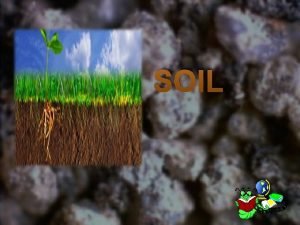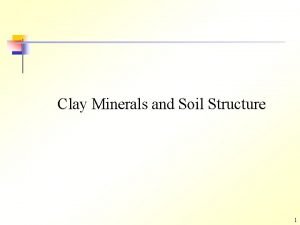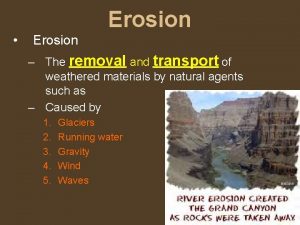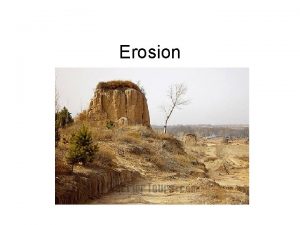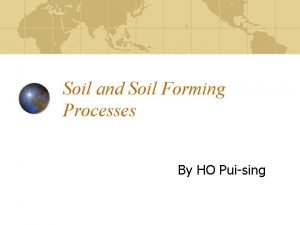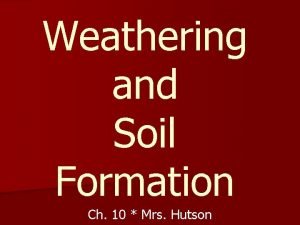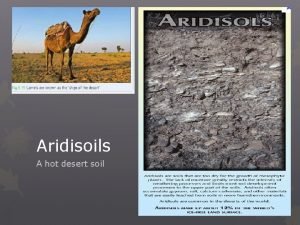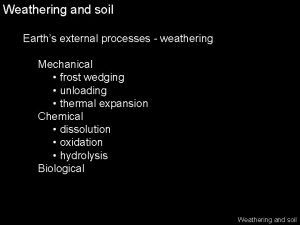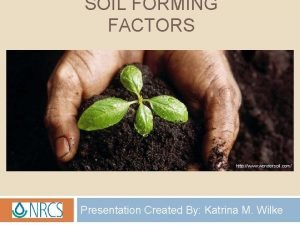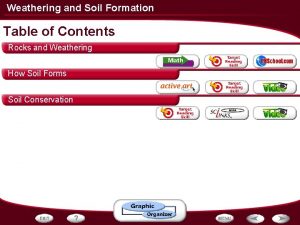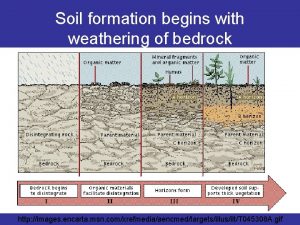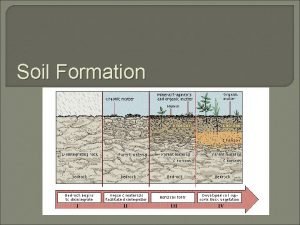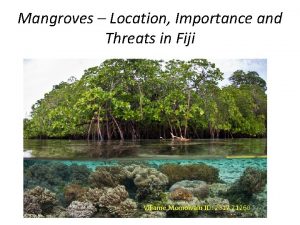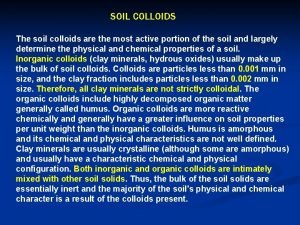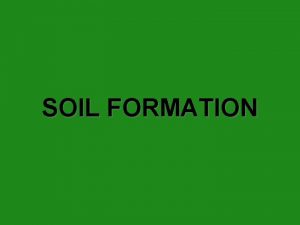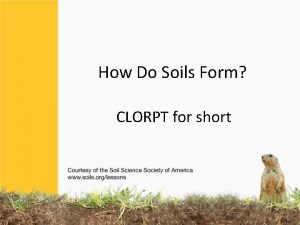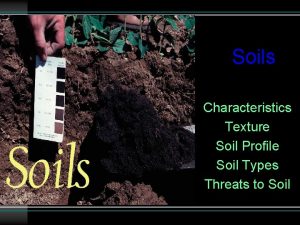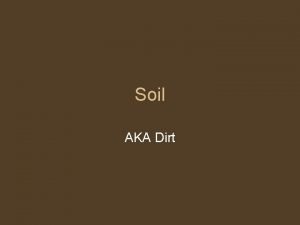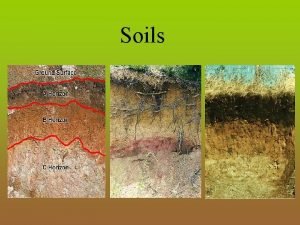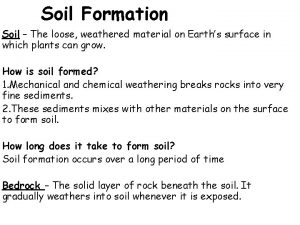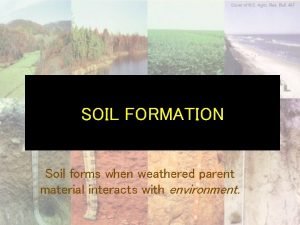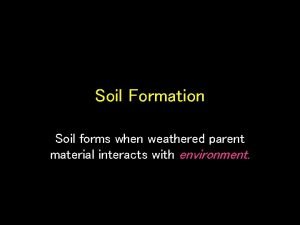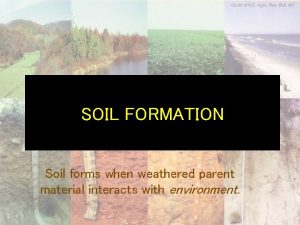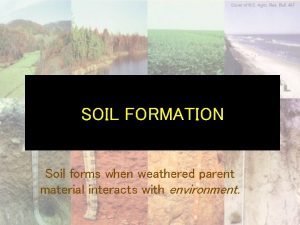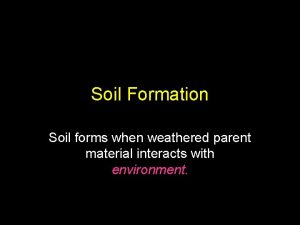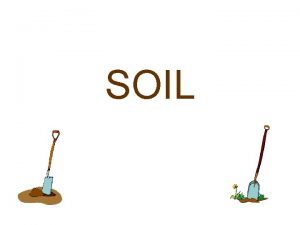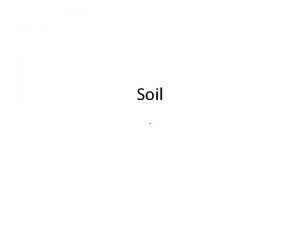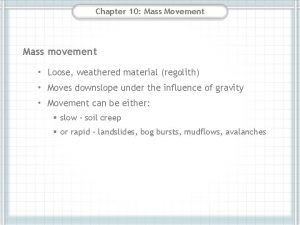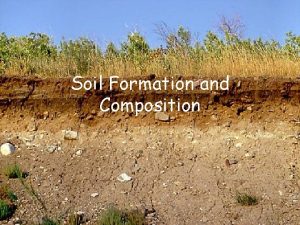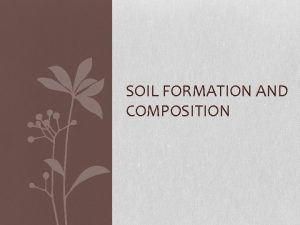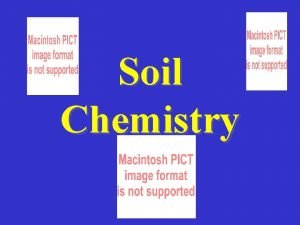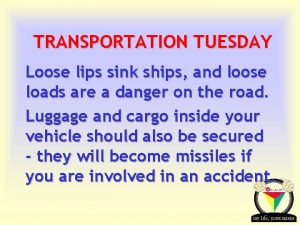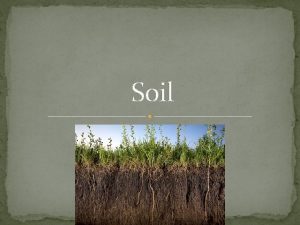Soil Formation Soil The loose weathered material on

































- Slides: 33


Soil Formation Soil – The loose, weathered material on Earth’s surface in which plants can grow. How is soil formed? Soil is formed as rock is broken down by weathering and mixes with other materials on the surface. Bedrock – The solid layer of rock beneath the soil. It gradually weathers into soil whenever it is exposed.

Soil Composition and Texture Soil is a mixture of rock particles, minerals, decayed organic material, air, and water. • Humus – Dark colored the decayed organic material in soil; helps create spaces in soil for air and water; rich in elements that plants need • Loam – soil made up of about equal parts of clay, sand, and silt; ideal for most plants

Soil Particle Size


Soil Horizons Soil horizon – layer of soil that differs in color and texture from layers above or below it. Topsoil – Mixture of humus, clay and other minerals that forms the crumbly, topmost layer of soil; the A horizon Subsoil – The layers of soil beneath the topsoil that contains mostly clay and other minerals; the B horizon

Soil rock and 1. Soil is a combination of Weathered _______ Organic matter _________. Humus 2. ______ = decayed plant and animal material found in soil. Soil that contains 20 -30% humus is considered a rich soil for plant growth. 3. Soil development

4. Soil layers- The soil profile Topsoil Horizon = ______ or A ______ the top layer of soil that contains more humus than the layers below. Sub soil or ______ B Horizon = ______ consists of clays and dissolved minerals that have been washed down from above. Contains less humus. C Horizon = consists of ______ weathered rock fragments, usually from the parent rock below. Bedrock = the layer of rock ______ beneath the soil. Frequently the parent rock of the soil above.

Georgia’s soil is Southern Forest soil – form in wet and warm climate; low in humus.

Living Organisms in soil


Forming Humus Litter – The loose layer of dead plant leaves and stems on the surface of soil. Decomposers – Soil organisms that breaks down the remains of dead plants and organisms and digest them.

Importance of Living organisms in Soil • Some soil organisms, like earthworms, mix the soil and make spaces in it for air and water. • Other soil organisms make humus, which makes soil fertile.


Soil Conservation • Soil is one of Earth’s most valuable resources because everything that lives on the land depends directly or indirectly on soil. • Fertile soil is valuable because there is a limited supply. – Less than 1/8 th of the land on Earth has soils well suited for farming.

Soil Damage and Loss • Soil can become exhausted, or lose its fertility. • Soil can also become lost to erosion by water and wind. – Water erosion can occur wherever soil is not protected by plant cover. – Wind erosion caused the Great Dust Bowl!! Sod – The thick mass of tough roots at the surface of soil keep the soil in place and hold onto moisture.

The Dust Bowl – Loss of Topsoil • In the 1930 s plowing removed the grass form the Great Plains and exposed the soil. In times of drought, the topsoil quickly dried out, turned to dust, and blew away. • This event helped people appreciate the value of soil. • Check It Out!!

Soil Lost To The Seas!!

How to help in Soil Conservation? • Soil Conservation is the management of soil to prevent its destruction. • Three ways that soil can be conserved include contour plowing, conservation plowing, and crop rotation.

Contour Plowing • Contour plowing is the practice of plowing fields along the contours of a slope. • This helps slow the runoff of excess rainfall and prevents it from washing the soil away.

Conservation Plowing • Conservation Plowing disturbs the soil and its plant cover as little as possible. • Dead weeds and stalks of the previous year’s crop are left in the ground to help return soil nutrients.

Farmers plants different crops each year Different type of crops absorb different types of nutrients from soil

Why Soil Conservation is important? http: //educationportal. com/academy/lesson/soilconservation-fighting-soil-erosion-withsustainable-soil-use. html#lesson

1. In which type of climate does chemical weathering usually occur most rapidly? 1. hot and dry 2. hot and wet 3. cold and dry 4. cold and wet

2. Which change in the climate of a location would most likely cause the greatest increase in chemical weathering of local bedrock? 1. lower temperature in winter 2. lower humidity in winter 3. higher atmospheric pressure in summer 4. greater precipitation in summer

3. Which type of climate has the greatest amount of rock weathering caused by frost action? 1. a dry climate in which temperatures remain below freezing 2. a dry climate in which temperatures alternate between below freezing to above freezing 3. a wet climate in which temperatures remain below freezing 4. a wet climate in which temperatures alternate between below freezing to above freezing

4. The diagram shows a process called frost wedging. Frost wedging is an example of 1. weathering 2. cementing 3. metamorphism 4. deposition

5. Landscapes will undergo the most chemical weathering if the climate is 1. cool and dry 2. cool and wet 3. warm and dry 4. warm and wet

6. Which activity demonstrates chemical weathering? 1. freezing of water in the cracks of a sandstone sidewalk 2. abrasion of a streambed by tumbling rocks 3. grinding of talc into a powder 4. dissolving of limestone by acid rain

7. Which process is best illustrated by the diagram? 1. cementation 2. erosion 3. metamorphism 4. weathering

8. As a result of the changes in temperature and amount of carbon dioxide, what probably happened to Earth's overall rate of chemical weathering during this time? 1. The rate of chemical weathering decreased. 2. The rate of chemical weathering increases. 3. The rate of chemical weathering remained the same

9. The diagram shows granite bedrock with cracks. Water has seeped into the cracks and frozen. The arrows represent the directions in which the cracks have widened due to weathering. Which statement best describes the physical weathering shown by the diagram? 1. Enlargement of the cracks occurs because water expands when it freezes. 2. This type of weathering occurs only in bedrock composed of granite. 3. The cracks become wider because of chemical reactions between water and the rock. 4. This type of weathering is common in regions of primarily warm and humid climates.

Why Soil Conservation is important? http: //educationportal. com/academy/lesson/soilconservation-fighting-soil-erosion-withsustainable-soil-use. html#lesson
 What is soil made of?
What is soil made of? Soil is a mixture of weathered rock and
Soil is a mixture of weathered rock and Soil is a loose mixture of
Soil is a loose mixture of Relative density of loose soil
Relative density of loose soil Use of continuous tubular rail as a barrier to excavations
Use of continuous tubular rail as a barrier to excavations Materials transported due to erosion
Materials transported due to erosion O captain my captain paraphrase
O captain my captain paraphrase The process by which natural forces move weathered
The process by which natural forces move weathered Formation initiale vs formation continue
Formation initiale vs formation continue Pedalfers
Pedalfers Eluviation vs illuviation
Eluviation vs illuviation Mechanical and chemical weathering venn diagram
Mechanical and chemical weathering venn diagram Soil layers
Soil layers Mechanical and chemical weathering venn diagram
Mechanical and chemical weathering venn diagram How soil is formed
How soil is formed Soil science ppt topics
Soil science ppt topics 5 factors of soil formation
5 factors of soil formation Soil formation begins with weathering of
Soil formation begins with weathering of What are the four processes of soil formation
What are the four processes of soil formation O a b c r
O a b c r Soil formation
Soil formation Granite weathering
Granite weathering What are soil colloids
What are soil colloids Soil textural triangle practice exercises
Soil textural triangle practice exercises Clorpt meaning
Clorpt meaning Living soil vs dead soil
Living soil vs dead soil Four major spheres of the earth
Four major spheres of the earth Characteristics of soil
Characteristics of soil Soil located above its parent material
Soil located above its parent material Soil horizon parent material
Soil horizon parent material Datum shift
Datum shift Example of material culture
Example of material culture Rsq in standard costing
Rsq in standard costing Useful and harmful at home
Useful and harmful at home
